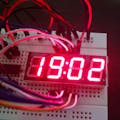Would you like to train your reaction time in milliseconds?
This project is a reaction timer using Arduino and more some components, but really simple and easy to be done.
The rules are very simple, similar to the Formula 1 racing start lights procedure:
"Once all cars have safely taken up their grid positions at the end of the formation lap five red lights will appear in sequence at one-second intervals. These red lights are then extinguished to signal the start of the race".
Note: After the last red light is lit, a random time (0 to 3 seconds) define when all red lights will be off. The total time from the first red light until all of lights are off varies between 4 to 7 seconds.
A 8 dig x 7 seg LED display is used to show the "lights on", your reaction time in milliseconds and also your best mark (minimum time achieved).
There are only 02 buttons:
- Start (button #1 on the left)
- Reaction Time (button #2 on the right)
If the time of 9.999 seconds has elapsed after all the lights are off, a warning signal "- - - -" will be displayed when you press the button #2.
If you jump start, the timer is blocked and a warning "JP" is shown on display.
The right way is to wait for all the lights off !!
Try to get better every time !!
- Arduino Uno R3
- LED Display with MAX7219 (8 Digits x 7 Segments)
- Tactile Button Switch
- Breadboard
- Jumper Wires
It is known that "the average reaction time for humans is 0.25 seconds to a visual stimulus, 0.17 for an audio stimulus, and 0.15 seconds for a touch stimulus".
I am not a neuro-scientist and this is not a scientific lab device, but with this project I have done some tests changing the code and I noticed some interesting points about how our brains work:
- If you keep a constant time in sequence at one-second intervals until extinguished all of lights, your brain learn about this time interval and then your reaction goes better time after time. There is a kind of syncronization between the beat of lights and your finger movement! In this case the response of time can be around 50ms or less!!
- A random time at the end of cycle assures a more realistic measures of time reaction, avoiding the effect described previously. If the random time is less than 200ms, your performance will be worst. For better results, the last light must be on for more than 200ms.
- Visual stimulus demands more brain processing and the time reaction is lower when the lights are just turned off comparing when the color of lights are changed. Maybe this was the reason to Formula 1 eliminated the green lights to start the race. Nowadays the race starts when all the red lights are off.


_ztBMuBhMHo.jpg?auto=compress%2Cformat&w=48&h=48&fit=fill&bg=ffffff)












_1x_bGT19vVAby.png?auto=compress%2Cformat&w=40&h=40&fit=fillmax&bg=fff&dpr=2)
_3u05Tpwasz.png?auto=compress%2Cformat&w=40&h=40&fit=fillmax&bg=fff&dpr=2)
Comments